Gujarat Board GSEB Textbook Solutions Class 12 Chemistry Chapter 13 Amines Textbook Questions and Answers, Additional Important Questions, Notes Pdf.
Gujarat Board Textbook Solutions Class 12 Chemistry Chapter 13 Amines
GSEB Class 12 Chemistry Amines InText Questions and Answers
![]()
Question 1.
Classify the following amines as primary, secondary or tertiary:
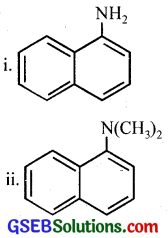
iii. (C2H5)2CHNH2
iv. (C2H5)2NH
Answer:
i. Primary (1°)
ii. Tertiary (3°)
iii. Primary (1°)
iv. Secondary (2°).
![]()
Question 2.
(i) Write structures of different isomeric amines corresponding to the molecular formula, C4H11 N.
(ii) Write IUPAC names of all the isomers.
(iii) What type of isomerism is exhibited by different pairs of amines?
Answer:
(i) and (ii)
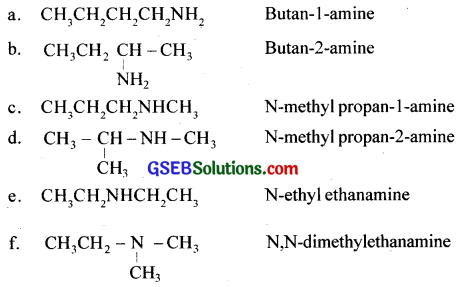
(iii) (a) and (b) are position isomers.
(c) and (d) are chain isomers.
(c) and (e) are metamers.
![]()
Question 3.
How will you convert
(i) Benzene into aniline
(ii) Benzene into N, N – dimethylaniline
(iii) Cl – (CH2)4 – Cl into hexan – 1, 6 – diamine?
Answer:

ii. Aniline obtained in the above reaction can be used.

Question 4.
Arrange the following in increasing order of their basic strength:
- C2H5NH2, C6H5NH2, NH3, C6H5CH2NH2 and (C2H5)2NH
- C2H5NH2, (C2H5)2NH, (C2H5)3N, C6H5NH2
- CH3NH2, (CH3)2NH, (CH3)3N, C6H5NH2, C6H5CH2NH2.
Answer:
- C6H5NH2 < NH3 < C6H5CH2NH2 < C2H5NH2 < (C2H5)2NH
- C6H5NH2 < C2H5NH2< (C2H5)3N < (C2H5)2NH
- C2H5NH2 < C6H5CH2NH2 < (CH3)3N < CH3NH2 < (CH3)2NH.
![]()
Question 5.
Complete the following acid-base reactions and name the products:
(i) CH3CH2CH2NH2 + HCl →
(ii) (C2H5)3N + HCl →
Answer:

Question 6.
Write reactions of the final alkylation product of aniline with an excess methyl iodide in the presence of sodium carbonate solution.
Answer:

Question 7.
Write chemical reaction of aniline with benzoyl chloride and write the name of the product obtained.
Answer:

Question 8.
Write structures of different isomers corresponding to the molecular formula, C3H9N. Write IUPAC names of the isomers which will liberate nitrogen gas on treatment with nitrous acid.
Answer:

(a) and (b) are primary amines and give N2 on treatment with nitrous acid
Question 9.
Convert
(i) 3 – Methylaniline into 3 – nitrotoluene.
(ii) Aniline into 1, 3, 5 – tribromobenzene.
Answer:
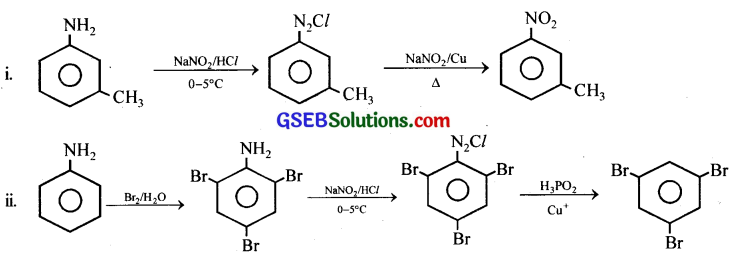
GSEB Class 12 Chemistry Amines Text Book Questions and Answers
Question 1.
Write IUPAC names of the following compounds and classify them into primary, secondary and tertiary amines.
(i) (CH3)2CHNH2
(ii) CH3(CH2)2NH2
(iii) CH3NHCH(CH3)2
(iv) (CH3)3CNH2
(v) C6H5NHCH3
(vi) (CH3CH2)2NCH3
(vii) m – BrC6H4NH2
Answer:
(i) 1-methylethanamine
(ii) Propan-1-amine
(iii) N-methyl-2-methylethanamine
(iv) 2-methylpropan-2-amine
(v) N-methylbenzamine or N-methylaniline
(vi) N-Ethyl-N-methylethanamine
(vii) 3-Bromoaniline or 3-Bromobenzenamine
![]()
Question 2.
Give one chemical test to distinguish between the following pairs of compounds.
(i) Methylamine and dimethylamine
(ii) Secondary and tertiary amines
(iii) Ethylamine and aniline
(iv) Aniline and benzylamine
(v) Aniline and N-methylaniline.
Answer:
(i) Methyl amine and dimethyl amine:
Methyl amine is a primary amine dimethylamine test.
CH3NH2 + CHCl3 + 3KOH → CH3NC + 3KCl + 3H2O
Dimethyl amine is a secondary amine and does not Methyl amine to dimethylamine test.
(ii) Secondary and tertiary amines:
Amines are classified as primary, secondary, or tertiary according to the number of carbons bonded directly to the nitrogen atom. Primary amines have one carbon bonded to the nitrogen. Secondary amines have two carbons bonded to the nitrogen, and tertiary amines have three carbons bonded to the nitrogen.Tertiary amines do not answer Liebermann’s nitrosoamine test.
(iii) Ethylamine and aniline:
Aniline reacts with NaNO2 and HCl followed by reaction with alkaline β – naphthol to give an orange coloured dye (Azo dye test).

(iv) Aniline and benzylamine:
Aniline answers dye test while benzyl amine does not.

(v) Aniline and N-methyl aniline:
Aniline being primary amine answers carbyl amine reaction while N – methyl aniline being secondary amine does not.
C6H5 – NH2 + CHCl3 + 3KOH → C6H5NC + 3KCl + 3H2O
C6H5 – NH – CH3 + CHCl3 + 3KOH → No reaction
![]()
Question 3.
Account for the following:
(i) pKb of aniline is more than that of methylamine.
(ii) Ethylamine is soluble in water whereas aniline is not.
(iii) Methylamine in water reacts with ferric chloride to precipitate hydrated ferric oxide.
(iv) Although amino group is o – and p – directing in aromatic electrophilic substitution reactions, aniline on nitration gives a substantial amount of m-nitroaniline.
(v) Aniline does not undergo Friedel-Crafts reaction.
(vi) Diazonium salts of aromatic amines are more stable than those of aliphatic aftiines.
Answer:
(i) In aniline, the lone pair of electrons on the N-atom are delocalised over the benzene ring thereby decreasing the electron density on N-atom. In CH3NH2, due to +I effect of – CH3, the electron density on N atom is high. Thus, aniline is a weaker base than methyl amine and has more pKb value.
(ii) Ethylamine can form H – bond with water and is soluble in water. But, in aniline, due to the large benzene ring, the extent of H-bonding decreases and is insoluble in water.
(iii) Methyl amine being more basic than water, accepts H+ ions from water and produces OH ions.
CH3 – NH2 + HOH → CH3\(\overset { + }{ N }\)H3 + OH–
These OH– ions combine with Fe3+ ions present in H2O to form a brown precipitate of hydrated ferric oxide.

(iv) When nitration is carried out with conc.HNO3 and conc.H2SO4, aniline gets protonated to form anilinium ion (-\(\overset { + }{ N }\)H3) which is m-directing and deactivating.

(v) Aniline being Lewis base reacts with Lewis acid AlCl3 to form salt. Thus, nitrogen of aniline acquires positive charge and hence acts as a strong deactivating group for electrophilic substitution and does not answer Friedel Craft’s reaction.
(vi) The diazonium salts of aromatic amines are more stable than those of aliphatic amines due to delocalisation of positive charge on benzene ring.
![]()
Question 4.
Arrange the following:
(i) In decreasing order of the pKb values: C2H5NH2, C6H5NHCH3, (C2H5)2NH and C6H5NH2
(ii) In increasing order of basic strength: C6H5NH2, C6H5N(CH3)2, (C2H5)2NH and CH3NH2
(iii) In increasing order of basic strength:
(a) Aniline, p – nitroaniline and p – toluidine
(b) C6H5NH2, C6H5NHCH3, C6H5CH2NH2.
(iv) In decreasing order of basic strength in gas phase: C2H5NH2, (C2H5)2NH, (C2H5)3N and NH3
(v) In increasing order of boiling point: C2H5OH, (CH3)2NH, C2H5NH2
(vi) In increasing order of solubility in water: C6H5NH2, (C2H5)2NH, C2H5NH2
Answer:
(i) C6H5NH2 < C6H5NHCH3 < C2H5NH2 < (C2H5)2NH
(ii) C6H5NH2 < C6H5N(CH3)2 < CH3NH2 < (C2H5)2NH
(iii) a. p-nitroaniline < aniline < p-toluidine
b. C6H5 NH2 < C6H5NHCH3 < C6H5NH2
(iv) (C2H5)3N > (C2H5)2NH > C2H5NH2 > NH3
(v) (CH3)2NH < C2H5NH2 < C2H5OH
(vi) C6H5NH2 < (C2H5)2NH < C2H5NH2
Question 5.
How will you convert:
(i) Ethanoic acid into methanamine
(ii) Hexanenitrile into 1 – aminopentane
(iii) Methanol into ethanoic acid
(iv) Ethanamine into methanamine
(v) Ethanoic acid into propanoic acid
(vi) Methanamine into ethanamine
(vii) Nitromethane into dimethylamine
(viii) Propanoic acid into ethanoic acid
Answer:
(i) Ethanoic acid into methanamine:

(ii) Hexanenitrile into 1-aminopentane:

(iii) Methanol to ethanoic acid:

(iv) Ethanamine to methanamine:

(v) Ethanoic acid into propanoic acid:

(vi) Methanamine to ethanamine:

(vii) Nitromethane into dimethylamine:
![]()
(viii) Propanoic acid into ethanoic acid:

![]()
Question 6.
Describe a method for the identification of primary, secondary and tertiary amines. Also write chemical equations of the reactions involved.
Answer:
Reaction with Hinsberg reagent – The amines react with benzene sulphonyl chloride, C6H5SO2Cl (Hinsberg reagent) to form sulphonamides.
(i) A primary amine gives a solid N-alkyl benzene sulphonamide which is soluble in alkali solution.

(ii) A secondary amine gives a solid N, N-dialkyl benzene sulphonamide, which is insoluble in alkali solution.

(iii) A tertiary amine does not react with the Hinsberg reagent.
(C2H5)3N + C6H5SO2Cl → No reaction
This reaction is used for the separation of three types of amines from a mixture of the three and also to distinguish them.
Question 7.
Write short notes on the following:
(i) Carbylamine reaction
(ii) Diazotisation
(iii) Hoffmann’s bromamide reaction
(iv) Coupling reaction
(v) Ammonolysis
(vi) Acetylation
(vii) Gabriel phthalimide synthesis.
Answer:
(i) Carbylamine reaction – Aliphatic and aromatic primary amines when warmed with chloroform and alcoholic KOH solution yield isocyanides or carbylamines. This reaction is called carbylamine reaction.

(ii) Benzene diazonium chloride is prepared by treating an ice cold solution of aniline in hydrohloric acid with sodium nitrite (NaNO2) at 0 – 5°C. This reaction is known as diazotization

(iii) Hoffmann’s bromamide reaction – When an acid amide is treated with bromine and alkali, at about 343 K a primary amine with one carbon atom less is formed.

This reaction offers a method of stepping down the series.
(iv) Coupling reaction – Diazonium salts readily undergo coupling reaction with electron rich compounds like phenols and amines to give coloured azo compounds.
(a) An ice cold solution of benzene diazonium chloride couples with an ice-cold solution of phenol in slightly alkaline solution to form p – hydroxyazo benzene.

(b) Coupling reaction between ice-cold solutions of benzene diazonium chloride and aniline in slightly acidic solution give p – aminoazo benzene.

(v) Ammonolysis – From alkyl halides: When an ethanolic solution of ammonia is heated with an alkyl halide in a sealed tube under pressure, a mixture of primary, secondary and tertiary amines along with quaternary amonium salt is formed.
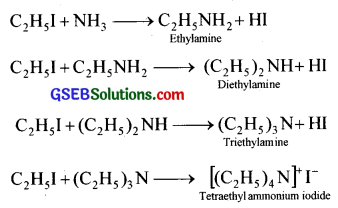
This reaction is an example of uminono/ysis which literally means splitting by ammonia. In the laboratory alkyl iodide is used, because it is easy to handle. On a large scale alkyl bromide is used (being cheaper). The order of reactivity is RI > RBr > RCl.
(vi) Acetylation – Amines can be acetylated by acetyl chloride or acetic anhydride to their respective acetyl derivatives. During acetylation of amines, hydrogen atom/s attached to nitrogen gets replaced by acetyl group. Primary amine can give diacetyl derivative whereas secondary amine can give only monoacetyl derivative. As tertiary amine does not carry replaceable hydrogen, it does not undergo acetylation.
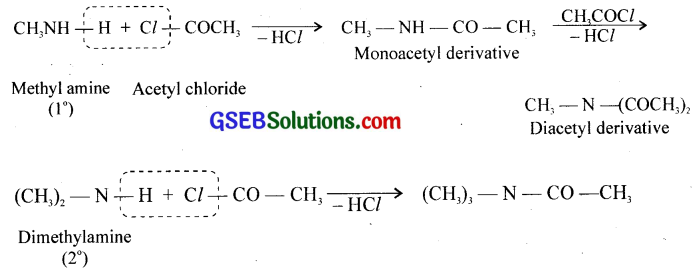
Acylation of aromatic amines using benzoyl chloride in presence of a base (benzoyation) is known as Schotten-Baumann reaction.

(vii) Gabriel phthalimide synthesis – Phthalimide when treated with alcoholic KOH, potassium phthalimide is formed. Potassium phthalimide on reaction with alkyl halide gives N – alkyl phihatimide which on hydrolysis gives primary amine.

![]()
Question 8.
Accomplish the following conversions:
(i) Nitrobenzene to benzoic acid
(ii) Benzene to m-bromophenol
(iii) Benzoic acid to aniline
(iv) Aniline to 2,4,6-tribromofluorobenzene
(v) Benzyl chloride to 2-phenylethanamine
(vi) Chlorobenzene to p-chloroaniline
(vii) Aniline to p-bromoaniline
(viii) Benzamide to toluene
(ix) Aniline to benzyl alcohol.
Answer:
(i) Nitrobenzene to benzoic acid:

(ii) Benzene to m-bromophenol:

(iii) Benzoic acid to aniline:

(iv) Aniline to 2,4,6-tribromofluorobenzene:

(v) Benzyl chloride to 2-phenylethanamine:

(vi) Chlorobenzene to p-chloroaniline:
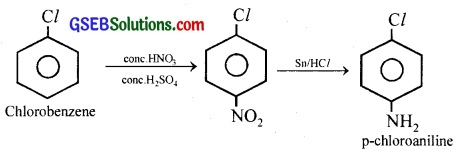
(vii) Aniline to p-bromoaniline:

(viii) Benzamide to toluene:

(ix) Aniline to benzyl alcohol:
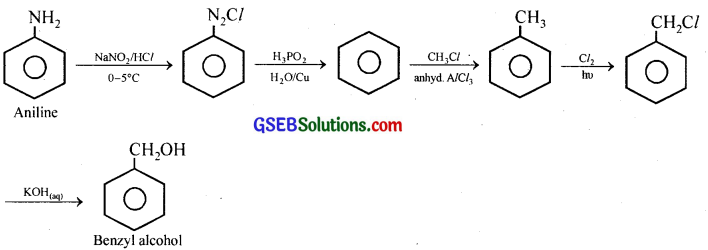
Question 9.
Give the structures of A,B and C in the following reactions.

Answer:

Question 10.
An aromatic compound ‘A’ on treatment with aqueous ammonia and heating forms compound ‘B’ which on heating with Br, and KOH forms a compound ‘C’ of molecular formula C6H7N. Write the structures and IUPAC names of compounds A, B and C.
Answer:
(i) Since ‘C’ is formed from ‘B’ on treating with Br2 and KOH, ‘B’ must be an amide and ‘C’ must be an amine. The only amine having the formula C6H7N is C6H5NH2 i.e., aniline. Since ‘A’ on treatment with aqueous ammonia and heating forms benzamide, ‘A’ must be benzoic acid.

![]()
Question 11.
Complete the following reactions:
(i) C6H5NH2 + CHl3 + alc.KOH →
(ii) C6H5N2Cl + H3PO2 + H2O →
(iii) C6H5NH2 + H2SO4(conc) →
(iv) C6H5N2Cl + C2H5OH →
(v) C6H5NH2 + Br2(aq) →
(vi) C6H5NH2 + (CH3CO)2O →
(vii)
Answer:

Question 12.
Why cannot aromatic primary’ amines be prepared by Gabriel phthalimide synthesis?
Answer:
Gabriel phthalimide reaction occurs through the nucleophilic attack by the phthalimide anion on the organic halogen compound.

Since aryl halides do not undergo nucleophilic substitution reactions easily, aromatic primary amines cannot be prepared by this method.
Question 13.
Write the reactions of (i) aromatic and (ii) aliphatic primary amines with nitrous acid.
Answer:
Aromatic primary amines react with HNO2 at 273-278 K to form diazonium salt while aliphatic primary amines give 1° alcohol.

Question 14.
Give plausible explanation for each of the following:
(i) Why are amines less acidic than alcohols of comparable molecular masses?
(ii) Why do primary’ amines have higher boiling point than tertiary amines?
(iii) Why are aliphatic amines stronger bases than aromatic amines?
Answer:
(i) Since, O is more electronegative than N, the alkoxide ion (R – O–) is more stable than amide ion (R – NH–).
R – OH → R – O– + H+
R – NH2 → R – NH– + H+
Thus, alcohol is more acidic than amine.
(ii) Due to the presence of two H atoms on N atom of primary amines, they can form strong intermolecular hydrogen bonding. While tertiary amines have no – H atom on the N atom and do not form H – bonding.
(iii) Due to resonance in aromatic amines, the lone pairs of electrons on the nitrogen atom gets delocalised over the benzene ring and less available for protonation. But the alkyl groups on nitrogen of alkyl amines have electron releasing +I effect which increases the electron density on nitrogen. Thus, aliphatic amines are stronger bases than aromatic amines.
![]()
GSEB Class 12 Chemistry Amines Additional Important Questions and Answers
Question 1.
Give the structure of five isomeric amines of formula C7H9N that contains a benzene ring. Give their names also.
Answer:

Question 2.
You are provided with an amine. Mention two chemical tests to check whether it is aniline or not.
Answer:
(i) Carbylamine reaction: Aliphatic and aromatic primary amines when warmed with chloroform and alcoholic KOH solution yield foul smelling isocyanides or carbylamines.

(ii) Bromine water test: Aniline when treated with bromine water gives a white precipitate of 2,4,6- tribromoaniline.
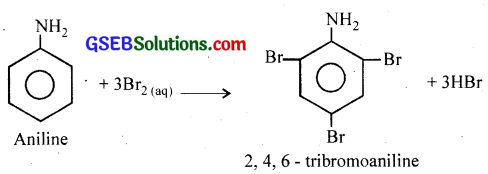
Question 3.
Aniline is insoluble in water but soluble in HCl. Explain.
Answer:
Being basic nature, aniline forms soluble salts with strong acids like HCl while with water no such salt is formed. Therefore, aniline is insoluble in water but soluble in HCl.
C6H5NH2 + HCl → \(\left[\mathrm{C}_{6} \mathrm{H}_{5} \mathrm{NH}_{3}^{+}\right] \mathrm{Cl}^{-}\)Aniline hydrochloride
![]()
Question 4.
How will you distinguish an aliphatic primary amine from an aromatic primary amine?
Answer:
Aliphatic primary amine reacts with nitrous acid to form alcohol.
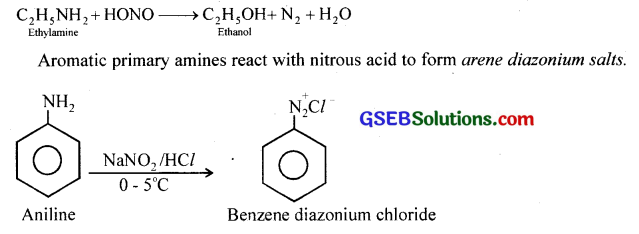
Above 5°C it decomposes to give phenol.
Question 4.
(i) Boiling point of alkyl cyanides is higher than alkyl halides of nearly the same molecular mass. Why?
(ii) B.P. and M.P. of isocyanides are less than isomeric cyanide compounds. Why?
Answer:
(i) Cyanide group (- C \(\cong\) N) is polar. Thus dipole moment of alkyl cyanide is higher due to which intermolecular force between them is higher. As a result boiling point of alkyl, cyanide is higher than alkyl halides of nearly the same molecular mass.
(ii) Isocyanide compounds are less polar than isomeric cyanides. Therefore, the boiling points and melting points of isocyanides are less than cyanides.
Question 6.
Identify the products obtained in the following reactions.
(i) C2H5 NH2 + H2 →
(ii) C2H5 NH2 + CHCl3 + 3KOH →
(iii) C2H5 NH2 + HNO2 →
(iv) C2H5 NH2 + HCl →
Answer:
(i) C2H5 NH3+ OH–
(ii) C2H5 NH2 + CHCl3 + 3KOH
(iii) C2H5 OH N2 + H2O
(iv) C2H5 NH3+Cl–
Question 7.
Suggest a method to distinguish the following pairs.
(i) Methyl amine and aniline.
(ii) Aniline and phenol.
(iii) Aniline and N-methyl aniline.
(iv) Methylamine and dimethylamine.
Answer:
(i) Reaction with HNO2: Methylamine reacts with nitrous acid with the evolution of nitrogen gas to form alcohol.
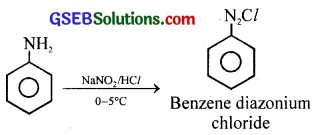
(ii) Aniline when warmed with chloroform and alcoholic KOH solution yields foul smelling gas, isocyanide or carbylamine.
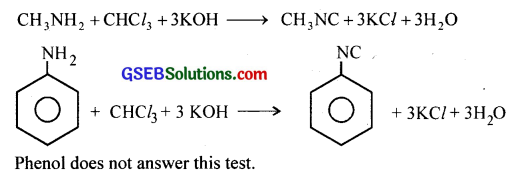
(iii) Carbylamine test. Aniline answers carbylamine test while N-methyl aniline does not.
C6H5NH2 + CHCl3 + 3 KOH → C6H5NC + 3KCl + 3H2O
(iv) Methyl amine when treated with chloroform and KOH, forms foul-smelling methyl isocyanide (carbylamine test).
![]()
Dimethylamine does not answer carbylamine test.
![]()
Question 8.
Arrange the following in the decreasing order of basic character. Justify your answer.
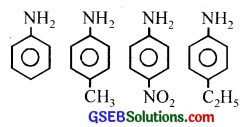
Answer:
Basic character decreases in the order

The electron releasing group increases the basic character and the electron-withdrawing group de-creases the basic character.
Question 9.
Identify A, Band C in the following reaction.
![]()
Answer:

Question 10.
Identify A, B and C.
![]()
Answer:
